The Shoulder Armor
 The Original Evil Ash armor was based on 15th century Italian and German armor. John Hart , one of the artists who worked on the original movie armor oh-so-long ago, dropped us a line and gave us some tips about the creation of the armor.
The Original Evil Ash armor was based on 15th century Italian and German armor. John Hart , one of the artists who worked on the original movie armor oh-so-long ago, dropped us a line and gave us some tips about the creation of the armor.
"The original concept was fossilized armor, steel fused with bone, with the color scheme black and rust with a little bit of shine here and there."
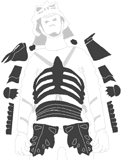 Our shoulder armor was constructed from 1/8 inch thick sheets of plastic. We drew a template of the armor onto the flat plastic, heated the plastic slowly over a stove-top heating element and curved the plastic to the desired shape.
Our shoulder armor was constructed from 1/8 inch thick sheets of plastic. We drew a template of the armor onto the flat plastic, heated the plastic slowly over a stove-top heating element and curved the plastic to the desired shape.
That's the easy way to say it.
The templates were created first in thick construction paper, sized up to the wearer for proper fitting, and then traced onto the plastic. The paper template is crucial in saving time with R&D. It takes less time to modify paper than it does to reheat a piece of wrong sized plastic.
Each shoulder armor is a different size and shape. The left shoulder armor is a bell looking shape while the right shoulder contours to the natural form of shoulder and the wearers breast.
Left Shoulder Armor
Here we needed to check how much of a curve we wanted for the left shoulder armor.
The final cut out left shoulder armor.
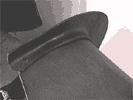 On the left shoulder armor Evil Ash had some sort of steel wall attached to the armor. I believe this wall was to protect the wearers neck from getting sliced by an opponents weapon.
On the left shoulder armor Evil Ash had some sort of steel wall attached to the armor. I believe this wall was to protect the wearers neck from getting sliced by an opponents weapon.
Once the plastic is pliable fit the wall to the shoulder bell exactly where you want to place the wall. Hold it in place until the plastic hardens back into
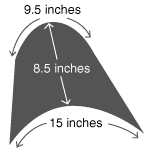
The left shoulder armor measured 9 inches around at the top , 15 inches at the bottom and it was 8.5 inches long.
Right Shoulder Armor
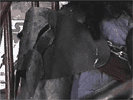 |
We created the right armor the same way. Creating a template out of paper first and then slowly heating the plastic over the oven to form it into the desired shape.
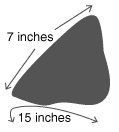
The right shoulder measured 15 inches from chest to back and 7 inches wide arcoss the shoulder.
Cowskull Ornament
 I will admit, this technique is a cheat on the authenticity of the costume, but one that saved me quite a few hours in production. You can sculpt out your own skull if you want, or better yet, hunt down a similar skull used in the real Evil Ash costume. Jeffry Hedgecock, original metal smith on the movie armor, says they took a cast off of a lawn ornament skull, made a plastic skull from that and bolted the plastic skull to the armor. What company made the lawn ornament is unknown as the piece was purchased in Southern California in the early 1990's and not documented.
I will admit, this technique is a cheat on the authenticity of the costume, but one that saved me quite a few hours in production. You can sculpt out your own skull if you want, or better yet, hunt down a similar skull used in the real Evil Ash costume. Jeffry Hedgecock, original metal smith on the movie armor, says they took a cast off of a lawn ornament skull, made a plastic skull from that and bolted the plastic skull to the armor. What company made the lawn ornament is unknown as the piece was purchased in Southern California in the early 1990's and not documented.
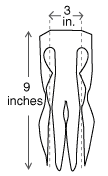
The cow skull is 9 inches long and 3 inches wide from the center eye -to- center eye.
Bicep Scale Armor
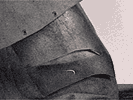 We needed some armor to cover the bicep region . The armor is just be two curved plates that over lay one another and cover the bicep. This type of overlaying armor plates is called scaling, just like fish scales.
We needed some armor to cover the bicep region . The armor is just be two curved plates that over lay one another and cover the bicep. This type of overlaying armor plates is called scaling, just like fish scales.
We use a -- cm wide strip of plastic as the basis for these scales.
The plastic curved and cut after heating.
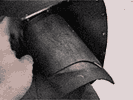 Notice we have about 3 inches of scale under the shoulder armor. This extra height lets the armor look natural when the arm gets raised up. or the shoulder pad is flopping around during intense movement. We riveted the armor plates to leather straps for connectivity.
Notice we have about 3 inches of scale under the shoulder armor. This extra height lets the armor look natural when the arm gets raised up. or the shoulder pad is flopping around during intense movement. We riveted the armor plates to leather straps for connectivity.
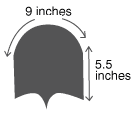 Our biceps measured 5.5 inches tall and 9 inches around. Your bicep armor might be bigger or smaller depending on your body size. We built our armor for a 5 foot 11 man. Average weight and build.
Our biceps measured 5.5 inches tall and 9 inches around. Your bicep armor might be bigger or smaller depending on your body size. We built our armor for a 5 foot 11 man. Average weight and build.
Cape Armor
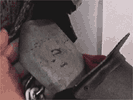 These plates also had some small metal cast skulls on them for decoration. We did not add these skulls to our armor due to time constraints.
These plates also had some small metal cast skulls on them for decoration. We did not add these skulls to our armor due to time constraints.
The final cape armor measured 4 inches wide and 3.5 inches front-to-back. You need to add in the "folded down side" measurment to your pattern when you make your plates.
-end of shoulder armor-